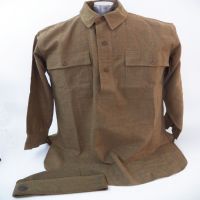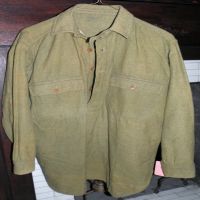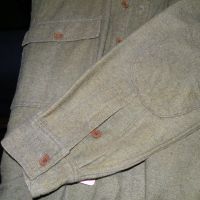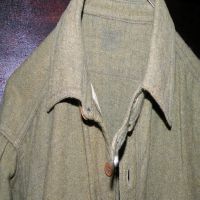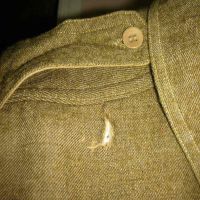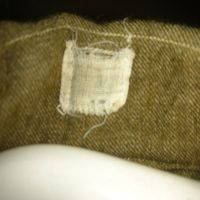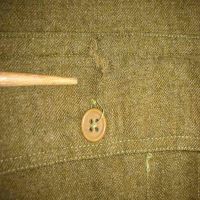Shirts
1911 Olive Drab Flannel Shirt
Details of the 1911 Olive Drab Flannel Shirt:
 Made from olive drab shirting flannel composed of 100% wool
Made from olive drab shirting flannel composed of 100% wool  Pullover style with a three button placket front
Pullover style with a three button placket front  Rolling collar
Rolling collar  Olive drab or brown buttons
Olive drab or brown buttons  Two breast patch pockets with a straight (not curved) bottom
Two breast patch pockets with a straight (not curved) bottom  Each straight pocket flap is secured by a single button
Each straight pocket flap is secured by a single button  Oval shaped elbow patch now on each sleeve
Oval shaped elbow patch now on each sleeve The reinforced sleeve opening was shortened to accommodate the oval elbow patch and it now terminated with a flat, not a pointed ending
The reinforced sleeve opening was shortened to accommodate the oval elbow patch and it now terminated with a flat, not a pointed ending
Sometime in 1911, the 1910 Flannel Shirt underwent a specification change. The purpose of the change was explained in the 1911 Quartermaster General's annual report:
That the present pattern olive-drab flannel shirt be retained, except that the same be provided with reinforced elbows. The shirts now being manufactured are made in accordance with said recommendation.
Quartermaster General's Annual Report to the Secretary of War for the Fiscal Year Ended June 30th 1911, page 28, 29
1913 Olive Drab Flannel Shirt
Details of the 1913 Olive Drab Flannel Shirt:
 Now made from olive drab shirting flannel composed of 80% wool and 20% cotton
Now made from olive drab shirting flannel composed of 80% wool and 20% cotton Pullover style with a three button placket front
Pullover style with a three button placket front  Rolling Collar
Rolling Collar  Olive drab or brown buttons
Olive drab or brown buttons  Two breast patch pockets with a straight (not curved) bottom
Two breast patch pockets with a straight (not curved) bottom  Each straight pocket flap is secured by a single button
Each straight pocket flap is secured by a single button  Oval shaped elbow patch on each sleeve
Oval shaped elbow patch on each sleeve  The reinforced sleeve opening was shortened to accommodate the oval elbow patch whose terminus was flat, not pointed
The reinforced sleeve opening was shortened to accommodate the oval elbow patch whose terminus was flat, not pointed
Because the 100% wool flannel shirts previously issued by the Army were notorious for shrinking during the laundering process, the 1911 Flannel Shirt underwent a specification change to correct that fault. The 1913 Quartermaster General's annual report explained exactly what changes were made:
Olive drab flannel shirts –. Complaints have been received that the shirts issued to the enlisted men of the Army shrunk during the process of laundering to such an extent as to change the fit of the collar; experiments have been conducted to secure a fabric that would be more satisfactory, resulting in the procurement of a quantity of flannel composed of 80 per cent wool and 20 per cent cotton. Shirts manufactured out of this material were subjected to trial by officers and enlisted men. The very satisfactory reports received from Texas and Puerto Rico conclusively show that the shirts are equally as serviceable and warm and that they do not shrink. Standards and specifications for the new material have been adopted and future purchases will be made in conformity therewith. The exact cost of the shirts made from the new material will be somewhat less than the former price, but cannot be exactly stated until a purchase of a quantity of the flannel shall have been made.
1916/1917 Olive Drab Flannel Shirt
Details of the 1916/1917 Olive Drab Flannel Shirt:
 Made from 8 ½ ounce olive drab shirting flannel composed of 80% wool and 20% cotton
Made from 8 ½ ounce olive drab shirting flannel composed of 80% wool and 20% cotton  Pullover style with a three button placket front
Pullover style with a three button placket front  Rolling Collar
Rolling Collar  Olive drab or brown buttons
Olive drab or brown buttons  Two breast patch pockets with a straight (not curved) bottom
Two breast patch pockets with a straight (not curved) bottom  Now each pocket now has a separate pencil/pen pocket
Now each pocket now has a separate pencil/pen pocket Each straight pocket flap is secured by a single button
Each straight pocket flap is secured by a single button  Oval shaped elbow patch on each sleeve
Oval shaped elbow patch on each sleeve  The reinforced sleeve opening was shortened to accommodate the oval elbow patch whose terminus was flat, not pointed
The reinforced sleeve opening was shortened to accommodate the oval elbow patch whose terminus was flat, not pointed
Sometime between 1916 and 1917, a pencil/pen pocket was added to the inside of each breast pocket (the side that faced the buttons). The pencil pocket is easily identified by a vertical row of stitching that runs parallel to the inside edge of each pocket.
Quartermaster General's Annual Report to the Secretary of War for the Fiscal Year Ended June 30th, 1913, page 23
Taken from
http://www.usmilitariaforum.com/forums/index.php?/topic/209257-us-army-shirts-1900-to-1919/
Currently, the correct 8 ½ ounce olive drab shirting flannel composed of 80% wool and 20% cotton is not available. Makers of reproduction WWI doughboy shirts use some type of wool flannel or the cotton doughboy shirt is also being reproduced. During the war, many private purchase shirts were made of a variety of fabrics including 100% wool. Since wool shirts make up the majority of the reproduced shirts, we can justify their use by saying that we are using private purchase items until such time that accurate fabrics are reproduced to replicate the 80% wool 20% cotton mix. It is assumed that cotton doughboy shirts were not seen in the trenches in any significant numbers, since the doughboys were shipped overseas with wool uniforms. Cotton shirts are appropriate for stateside impressions and as a last option for a shirt when in the trenches.
Since the Ebony Doughboy was resupplied by the French once his US-issued uniform pieces began to wear out, we can assume that some French shirts were worn in the trenches. This assumption is supported by documentation that the 372nd Infantry was issued French undergarments when their US-issued undergarments wore out. Shirts are a clothing item that withstood rigorous hard use and had to be replaced frequently. There was a constant need for replacements for this item and it is believed that the Ebony Doughboy looked to the French for his source of replacement shirts. That being said, information on the French shirt shirt or chemise can be found at (151st website).
Pictures of the French chemise can be seen below:


